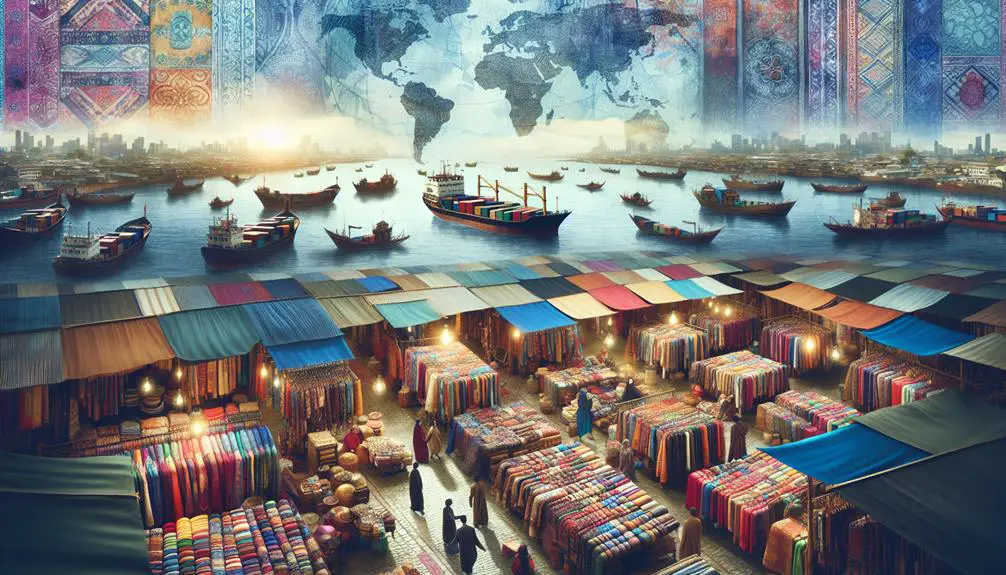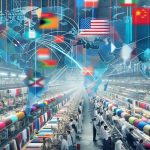While free trade agreements can open doors for international markets, import restrictions can slam them shut, both altering the dynamics of the textile industry. You might wonder how tariffs and quotas directly influence production costs and consumer prices. These trade policies shape everything from supply chains to market competition. Ever thought about how export incentives could help offset high labor costs and enhance global competitiveness? Understanding these elements is essential for grasping the broader picture of how trade policies impact textile businesses worldwide.
Table of Contents
Key Takeaways
- Tariffs and quotas impact textile costs and availability, affecting consumer prices and market dynamics.
- Free trade agreements lower tariffs, reshape industry economics, and enhance global market access.
- Import restrictions like quotas protect domestic industries but increase costs for manufacturers and consumers.
- Export incentives boost competitiveness, offset high labor costs, and help access new markets.
- Regional trade blocs simplify trade, enhance competitiveness, and reduce administrative overhead.
Tariffs and Quotas
Tariffs and quotas directly impact the cost and availability of textiles in the global market. When a country imposes tariffs on imported textiles, these additional costs are often passed on to you, the consumer. This protectionism aims to shield domestic industries from foreign competition, but it also means higher prices for imported goods.
Quotas, on the other hand, limit the quantity of textiles that can be imported, creating supply constraints that can further drive up prices.
In a trade war, countries retaliate against each other's tariffs and quotas, disrupting the supply chain and creating uncertainty in the market. You might find that the range of available textiles shrinks as countries impose stricter measures to protect their local manufacturers.
This tit-for-tat escalation can lead to significant fluctuations in textile prices and availability, making it harder for businesses to plan and for consumers to access diverse products.
Free Trade Agreements
You'll find that Free Trade Agreements greatly impact the textile industry's economic landscape. They offer market access benefits, allowing you to reach new consumers and boost sales.
Analyzing these economic impacts helps you understand the broader implications for your business.
Economic Impact Analysis
Free trade agreements frequently reshape the economic landscape of the textile industry by altering competitive dynamics and market access. As these agreements come into play, you'll notice significant changes in employment opportunities within the sector. Companies might shift their production bases to countries with lower labor costs, potentially causing job losses domestically. However, new markets can also open up, creating new roles and diversifying employment opportunities.
Supply chain disruptions are another vital factor. These can occur when trade policies change, affecting the flow of raw materials and finished goods. You must manage these disruptions efficiently to maintain production timelines and cost-effectiveness.
Consumer affordability is another aspect deeply influenced by free trade agreements. With reduced tariffs and increased competition, you'll often find that prices for textile products decrease, benefiting consumers. However, this can lead to trade balance implications, where the value of imports might exceed exports, affecting the overall economy.
Understanding these economic impacts is essential. You need to navigate the complexities of free trade agreements to leverage their benefits while mitigating potential downsides. Stay informed and agile to secure your business thrives in this ever-evolving landscape.
Market Access Benefits
Opening up new markets through free trade agreements can greatly boost the textile industry's growth potential. By eliminating tariffs and reducing trade barriers, these agreements enable you to access new customer bases and diversify your supply chain. This not only increases your revenue but also enhances your resilience to market dynamics.
Consider the following benefits of free trade agreements:
| Benefit | Impact |
|---|---|
| Reduced Tariffs | Lower costs for raw materials |
| Expanded Markets | Access to a larger customer base |
| Improved Supply Chain | Diversification of suppliers |
| Competitive Advantage | Better positioning against rivals |
| Economic Stability | Reduced vulnerability to local shocks |
By lowering tariffs, your costs for raw materials and finished products decrease, making your offerings more competitive. Expanding into new markets means you're not overly reliant on any single economy, which is essential for maintaining stability amid fluctuating market dynamics. Improvements in the supply chain, such as sourcing from multiple countries, mitigate risks associated with regional disruptions.
Free trade agreements also give you a competitive advantage. With fewer trade barriers, you can react more swiftly to market changes and customer demands. Finally, by spreading economic activities across diverse regions, you reduce your vulnerability to local economic shocks, ensuring a more stable business environment.
Import Restrictions
When you consider import restrictions, you'll notice how tariffs can greatly impact the cost of textile goods.
Quota systems also play an important role by limiting the quantity of imports, which can protect domestic industries but may lead to higher prices for consumers.
Understanding these effects is essential for grasping the broader implications of trade policies on the textile sector.
Tariff Impact Analysis
Tariffs on textile imports can greatly alter market dynamics by increasing costs for both manufacturers and consumers. When tariffs are imposed, they create several ripple effects throughout the supply chain and affect industry growth in significant ways. You need to understand these key impacts to navigate the complexities of the textile market effectively.
Supply Chain Disruptions:
Tariffs can lead to higher costs for raw materials and intermediate goods, causing supply chain inefficiencies. Manufacturers may face delays and increased expenses, which can trickle down to consumers in the form of higher prices.
Industry Growth Stagnation:
Increased production costs due to tariffs can stifle industry growth. Companies may reduce investments in innovation and expansion, ultimately hindering their competitive edge in the global market.
Consumer Price Increases:
Higher tariffs mean higher import costs, which often get passed on to consumers. This can lead to reduced demand for textile products, further impacting manufacturers' revenue streams and market share.
Quota System Effects
Quotas on textile imports can severely limit market access, forcing manufacturers to navigate a maze of restrictions and reduced supply opportunities. You'll find that these constraints often lead to trade diversion, where importers turn to alternative markets to fulfill their demands. This isn't just a minor inconvenience; it significantly reshapes the entire supply chain. When primary suppliers hit their quota limits, secondary markets become essential, even if they're less efficient or more costly.
Market saturation becomes another pressing issue. As quotas cap the volume of imports, domestic producers face less competition. Initially, this might seem beneficial, but it can result in oversupplied markets. With fewer competitors, prices may drop, but so could the quality of products as local manufacturers are less pressured to innovate. You'll notice that this artificial limiting of competition stifles market dynamism and consumer choice.
Understanding these quota effects helps you grasp the broader implications for the textile industry. It's not merely about limiting imports; it's about how these restrictions ripple through the market, influencing everything from supply chain logistics to product quality. By mastering these dynamics, you'll navigate the complexities of trade policies more effectively.
Export Incentives
Export incentives play a crucial role in boosting the competitiveness of a nation's textile industry on the global stage. By providing financial benefits, these incentives help you navigate the complexities of international markets. They can reduce overhead and make your products more attractive to foreign buyers.
Here's how you can leverage export incentives effectively:
- Streamline Your Supply Chain: Export incentives often include subsidies or grants to improve your supply chain. This can help you source raw materials at lower costs, ensuring that your production process is both efficient and cost-effective.
- Offset High Labor Costs: In countries where labor costs are high, export incentives can level the playing field. They may offer tax breaks or direct financial support to help you manage wages and benefits, making your products more price-competitive without compromising on quality.
- Access New Markets: Export incentives can also cover costs associated with market research and international marketing efforts. This enables you to expand your reach, identify potential buyers, and establish a strong presence in new regions.
Regional Trade Blocs
Building on the advantages offered by export incentives, engaging with regional trade blocs can further enhance your textile business's global competitiveness. By becoming part of a customs union, you're able to trade with member countries without the hindrance of trade barriers. This seamless flow of goods can substantially reduce costs and delivery times, making your products more attractive in the international marketplace.
Within these regional trade blocs, your business benefits from harmonized regulations and standards, which simplifies compliance and reduces administrative overhead. By focusing on these markets, you can also tailor your products to meet specific regional preferences, thereby increasing your market share.
Additionally, the collective bargaining power of a customs union can help you negotiate better terms with suppliers and customers alike, further strengthening your competitive edge.
Another key advantage is the potential for collaborative innovation. Being part of a regional trade bloc allows you to tap into a wider pool of research and development resources, fostering innovation in textile manufacturing and design. By leveraging these opportunities, your business can stay ahead of industry trends and maintain a competitive advantage in a rapidly evolving market.
Impact on Pricing
Understanding the impact on pricing is essential for your textile business to strategically navigate international markets. Trade policies directly affect your supply chain, altering costs and influencing pricing strategies. As you adapt, consider how these changes shape consumer behavior and your competitive edge.
- Tariffs and Duties:
Tariffs can inflate the cost of imported raw materials, leading to higher production costs. You'll need to decide whether to absorb these costs or pass them on to consumers, risking reduced demand.
- Subsidies and Incentives:
Government subsidies can lower your production expenses, enabling you to offer competitive prices. Keep an eye on incentives that could make your products more appealing to cost-sensitive consumers.
- Exchange Rates:
Fluctuations in exchange rates can notably impact your pricing strategy. A weaker domestic currency can make exports cheaper and more attractive, while a stronger currency can lead to higher prices for international buyers.
Global Competition
Managing global competition in the textile industry requires continuous innovation and adaptation to shifting market dynamics. To stay ahead, leveraging technological advancements to streamline operations is crucial. Automation and AI-driven solutions can optimize the supply chain, reducing lead times and costs. By integrating these technologies, efficiency can be enhanced to maintain a competitive edge.
Understanding the global supply chain is essential for success. Diversifying sourcing strategies can mitigate risks associated with geopolitical tensions and trade disputes. Sourcing raw materials from multiple regions allows for quick adaptation to changes, ensuring uninterrupted production.
Staying informed about the latest textile technologies is key to remaining competitive. Innovations like smart textiles and sustainable materials can differentiate a company from its competitors. Investing in research and development can lead to breakthroughs that appeal to discerning consumers seeking cutting-edge products.
Fostering strong relationships with international partners is also important. Collaboration can provide insights into emerging trends and opportunities, leading to mutually beneficial outcomes, expanding market reach, and enhancing the brand's reputation.
Frequently Asked Questions
How Do Trade Policies Affect the Sustainability of the Textile Industry?
Have you ever wondered what truly shapes the textile industry's future? Trade policies do. They can make or break sustainability by influencing environmental impact and market access, ultimately determining how eco-friendly and accessible products are.
What Role Do Labor Standards Play in Textile Trade Policies?
When you consider labor standards in trade policies, you're ensuring worker rights and compliance. By upholding ethical practices in global supply chains, you promote fairness and sustainability, ensuring that ethics aren't sacrificed for profit.
How Can Small Businesses Navigate Complex Trade Regulations in the Textile Sector?
Ever wondered how small businesses can overcome regulatory compliance challenges? You'll need sharp strategies and a keen eye for export opportunities. Mastering these elements lets you navigate complex trade regulations and release your company's full potential.
What Is the Impact of Trade Policies on Textile Innovation and Technology?
You'll find that trade policies shape market competition and drive technological advancements. They impact the global supply chain, encouraging streamlined processes and fostering economic growth, thereby pushing the textile industry toward greater innovation and efficiency.
How Do Geopolitical Tensions Influence Trade Policies in the Textile Industry?
You'll notice geopolitical influences often shape trade policies, directly impacting industry competitiveness. Tensions can lead to stricter regulations or tariffs, forcing companies to innovate or seek new markets to maintain their competitive edge.
- How Does Ring Spun Cotton Affect Garment Fit and Shape Retention? - August 13, 2024
- What Are the Challenges in Producing Ring Spun Cotton? - August 13, 2024
- Is Ring Spun Cotton Suitable for Plus-Size Clothing? - August 13, 2024







